| 1 | One of the only poisonous snakes |

Poison enthusiasts among you (if such a thing exists) might be cringing at that title. No, a snake injects venom, you might be thinking. However, the red-necked keelback is a very special snake, as it’s one of a handful worldwide to possess both poison and venom.
Red-necked keelbacks are found in a vast swathe of southeast Asia, from Hong Kong in the north, through Thailand and Vietnam, to the Indonesian island of Java in the south. They’re mainly found in watery areas, including those near humans such as ponds and drainage ditches in towns. The venom of this species comes from its classic venom glands, and possesses dangerously haemotoxic qualities. The poison meanwhile, comes from their diet of lethal Bufo toads.
Red-necked keelbacks prey nearly entirely on amphibians, and are resistant to poisonous toads which would stop the average human being’s heart in minutes. Such prey include Asian common toads, and Chusan island toads. Not only are red-necked keelbacks resistant to toad bufotoxins, but they possess the ability to store those toxins for future usage, in the form of a white liquid. Red-necked keelbacks thus became poisonous themselves, and a deadly meal which no predator should consider eating.
| 2 | Blasts people with toad toxins |
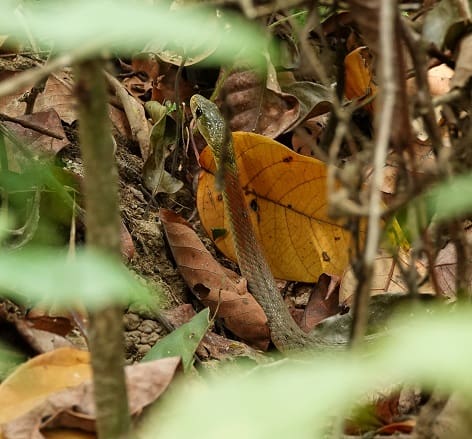
Red-necked keelbacks not only store bufotoxins in their bodies, but are able to use them as an offensive weapon, against humans and birds alike. After ingestion, the bufotoxins are stored in special nuchal glands, which are located directly in their namesake red neck. The nuchal glands consist of a very delicate, thin sac, which is easily burstable.
If a scientist or villager approaches this Thai snake overconfidently, believing them to be no threat, then the red-necked keelback will roll over and angle its neck towards the aggressor. Then they’ll deliberately burst the nuchal glands, unleashing the stolen toad poisons as a defensive measure. This can strike the aggressor in the face or even the eyes.
Sometimes, the white poison will merely dribble down their back, but red-necked keelbacks have also been observed firing a poisonous mist in to the air. A handful of other snakes worldwide have this ability, all of which are close relatives, such as the orange-necked keelback or tiger keelback of Japan.
Touching a red-necked keelback is an even worse idea than approaching one. They’re able to fire their poison stash at will, but physical touch can also cause the nuchal glands to burst in your face, even if the snake isn’t paying attention to you.
| 3 | Thailand’s most underestimated snake |
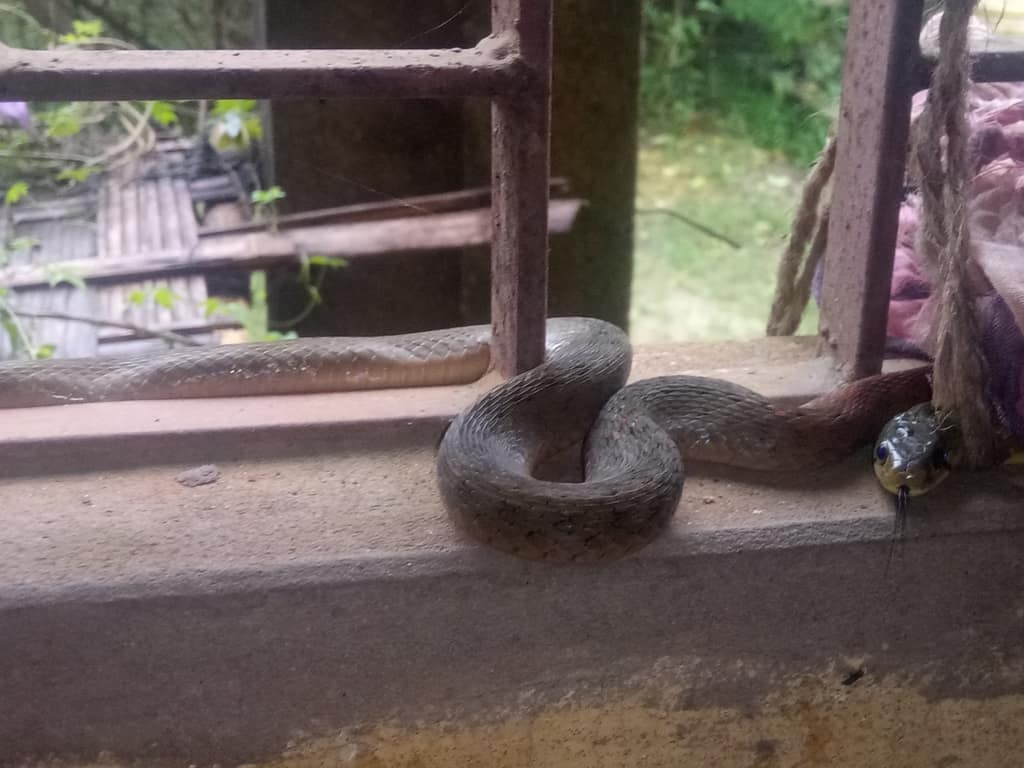
Originally, the red-necked keelback was regarded as a pretty, but non dangerous member of Thailand’s wildlife. That all changed in 1978, when a British scientist was bitten 4 times on the index finger while handling the snake roughly. There were no symptoms except a mild tingling and numbness, until approximately 20 hours post bite, when he locked the toilet door and produced a steady stream of black urine. His fibrinogen plummeted, his blood clotting failed so completely that none was recordable, and he only survived thanks to 10 donated blood units over 4 days.
Red-necked keelbacks possess a venom which wreaks utter destruction on red blood cells. Bites are uncommon, but deaths have been reported, and in hospital, doctors even refrain from injecting needles. The clotting becomes so impaired that even a tiny pinprick could cause fatal bleeding.
Red-necked keelback venom has the power to cause brain haemorrhages, and also kidney failure, while possessing very few neurotoxins. At 1.2mg in humans, the LD50 rating isn’t world class (if that’s the right term), but almost matches the blue coral snake at 0.81mg. This is one snake you don’t want to mess with.
| 4 | Chews venom into its victims |
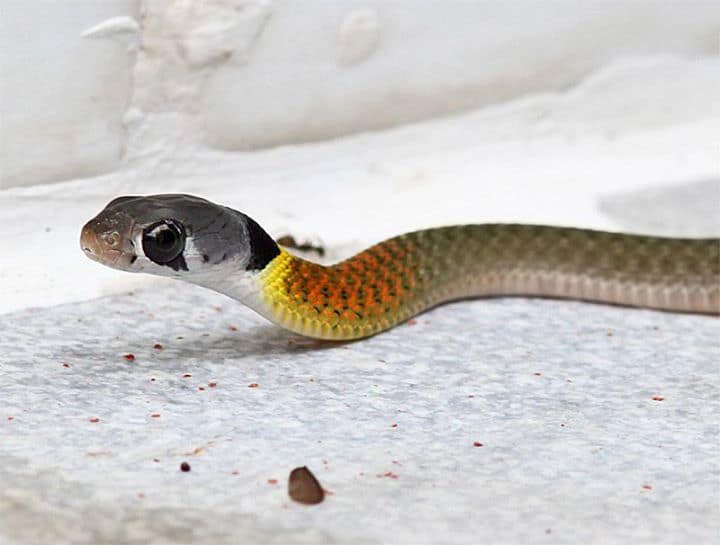
One reason why red-necked keelbacks were underestimated is that their front fangs don’t produce any venom. Instead, they’re a rear-ranged snake, which produces venom from a special gland called the Duvernoy’s gland. The average cobra can leap and bite and inject 100mg of venom instantly, but Rhabdophis subminiatus is forced to chew its victims for at least 2 minutes, allowing droplets of venom to run down the fangs and soak into the wound.
Consequently, the front fangs are grooved rather than hollow, to create a mini water canal. Studies confirm that hospitalising bites involve 2 minutes of relentless chewing, often with multiple bites (including 4 bites in the 1978 case). Their favourite place to bite is the tip of the index finger.
Many victims, including local villagers, are reluctant to shake this snake off for fear of hurting it, or are relaxed about its harmless reputation, having failed to hear the recent update. Those victims don’t realise that they are victims until it’s too late. The happy flipside is that dry bites are more common than usual with this species.
| 5 | Non-existent antivenom |
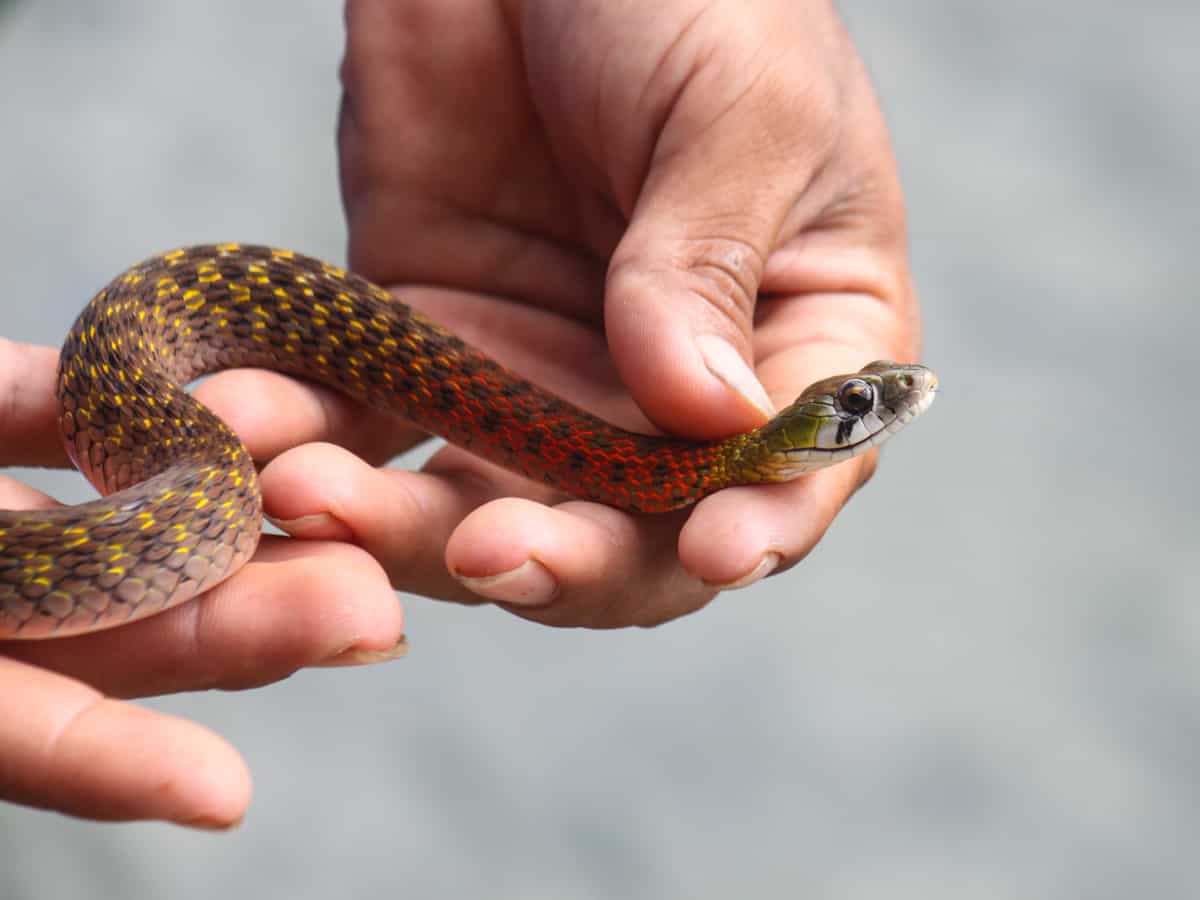
Red-necked keelbacks are a rare Thai snake to have no specific antivenin available. There’s no instant glass vial of liquid for red-neck toxins, except in Japan, which manufactures very small quantities for their own usage. Tiger keelback venom is used as an alternative, but as you’d expect, only gets 50% of the way there.
In 1990, red-necked keelbacks were the source of a huge panic on the streets of New York. The NYTimes reported that Petland USA had imported what they believed to be 150 red-headed garter snakes, a harmless American breed. Soon though, a keen-eyed customer was ringing up the ASPCA insisting that he’d seen a red-necked keelback, in a Petland Discount in New York. 3 of the deadly snakes had already been sold in Manhattan, and 2 in Brooklyn.
New York rapidly plunged into a weekend snake scare. What would happen next? Would the keelbacks escape and start a colony in the sewer system, like those infamous alligators of legend? The ASPCA swooped in and moved the snakes to Bronx zoo, but in the end, Petland was exonerated. The 150 snakes turned out to be buff-striped keelbacks, a totally harmless lookalike.
| 6 | Habitat: watery forest zones |
Red-necked keelbacks are almost always found near water, but that doesn’t mean they’re a coastal species. Instead, red-necked keelbacks stick to inland areas, including forests with rivers or marshes running through them. Ponds are the best spots of all, for guaranteeing a constant supply of their toad snakes. Then there’s swimming pools: any garden containing one is liable to be invaded.
Red-necked keelbacks like to hide in long grasses when feeling shy, and their abundance varies wildly. On some days, they can be nowhere, but on humid evenings, the forest floor can be crawling with them. Red-necked keelbacks occasionally climb into bushes to rest, but they’re mainly a ground-dwelling species. That includes rice fields, where they join characters such as the Russell’s viper.
Red-necked keelbacks have a giant range, stretching from Nepal in the far northwest, to Sulawesi in the far southeast. Hong Kong is a particular stronghold, with plentiful encounters, despite being almost completely urbanised. One unsolved mystery is whether they inhabit Singapore or not.
| 7 | The signature red neck |
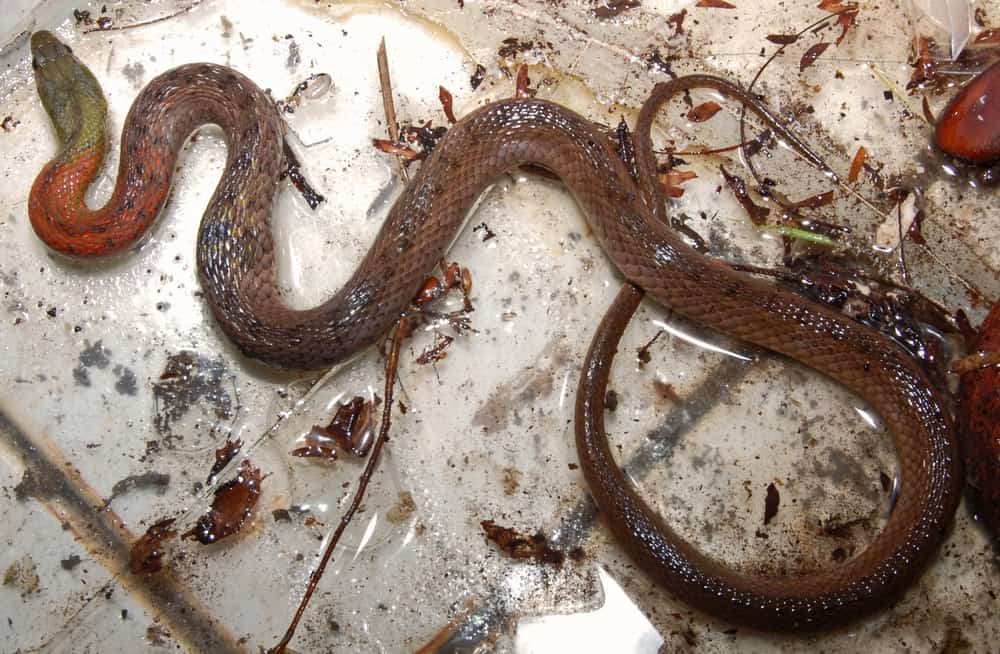
The adults of this species have red necks, but as younglings, the neck is sometimes so colourful that it’s like an artist has spilt his paint palette over it. The red is there, but not consistently and unbroken. There’s also yellow speckles, white dots, and sometimes blue markings, contrasting against each other like an electrocuted rainbow.
This ends at the head, where the chaos suddenly transitions into a solid black patch. After this comes a hard steel colour, like the robotic skull of a T-800. The body features scales in a honeycomb pattern, with alternating black and yellow lines inbetween.
As adults, the flashy colours slowly fade. The body transitions to olive-green, with only subtle patterns remaining. The head also transitions to green, and the solid black patch on the neck sometimes fades into nothingness. Younglings are flashier than adults in every zone except the signature red neck. In younglings, the redness is intermingled with yellow, while in adults, it’s solid and barely interrupted.
| 8 | Rarely exceeds 70cm |
Red-necked keelbacks have one other telltale mark – a black patch below the eye, pouring down like a waterfall. Occasionally, this is missing, and it’s sometimes broken into multiple lines, but it’s there more often than not. Hunted animals often identify predators by their round, menacing eyes, so it’s possible that this evolved to distort the image (as its eyes are also black).
Rhabdophis subminiatus is a fairly short snake, averaging at just 60-80cm. 1 metre red-necks have been rumoured, but this Thai snake enthusiast has never seen one. Even the long-accepted average might be too high, as in one study covering 46 snakes, the highest female length was 75.9cm, and the maximum male length was 56.3cm. Only 3 of the snakes exceeded 60cm.
Never let your guard down, as melanistic red-necked keelbacks have been spotted before, a keelback which breaks all the rules. These versions lack any colour except for medium grey car tyre. Even the signature red neck is missing. Here’s a picture of one observed in Hong Kong.
| 9 | Touch them at your peril |
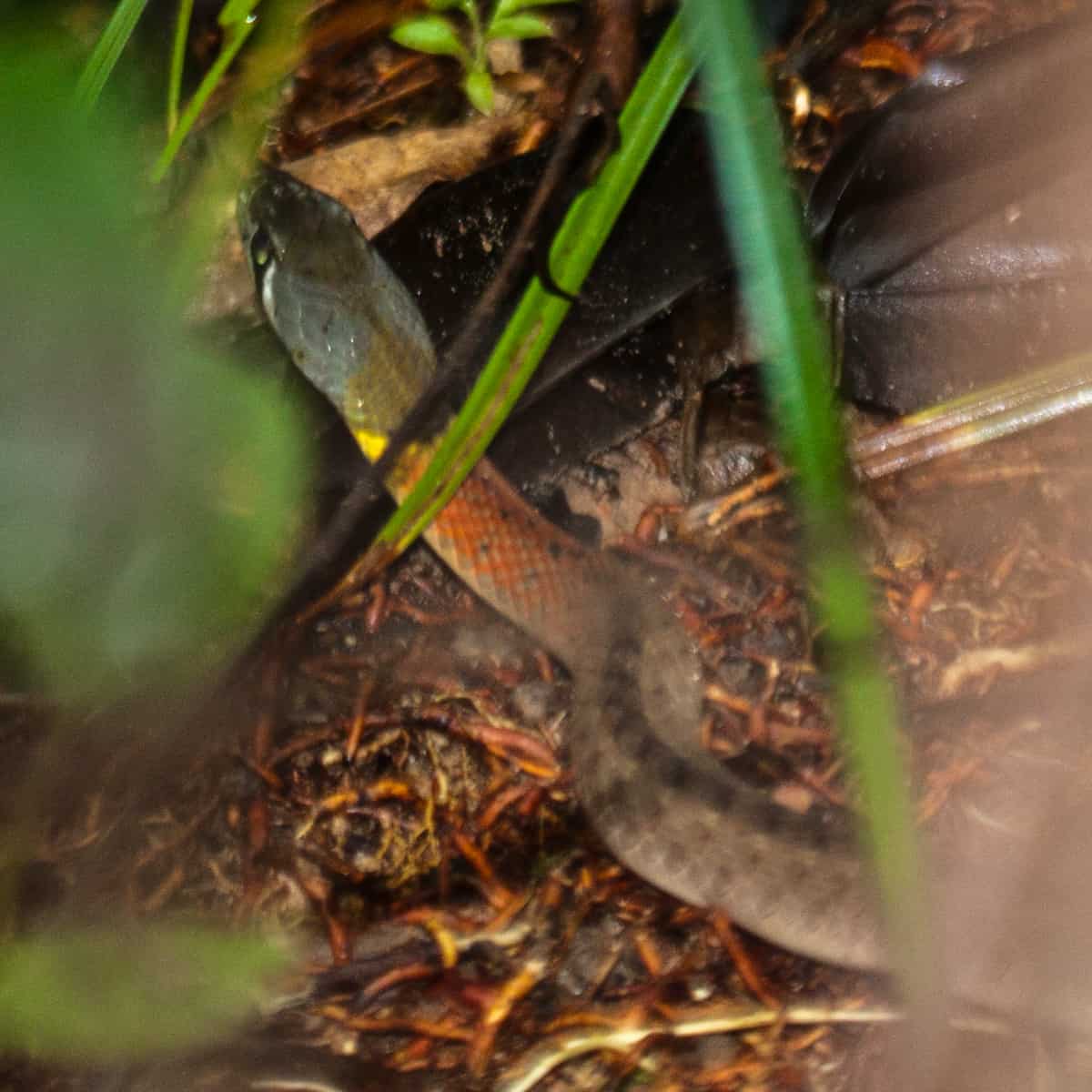
Ordinarily, red-necked keelbacks are completely docile, and have no interest in biting people. When sitting in bushes 1 foot above ground, explorers have pushed a camera inches from their face and taken flashing pictures with no response. Others simply flee, scurrying away into the bushes. Their venom is incredibly toxic, but they have no burning desire to show it off.
The change comes when touched. Contact with a hand or finger flips a switch in the red-necked keelback’s brain, bringing up their aggressive responses 100% of the time (study). This involves flaring their neck like a cobra, from an S-shaped coil. The flaring isn’t particularly wide, but uniquely, the red colour intensifies, from an already bright starting point.
Never pick this snake up – it’s nearly guaranteed to result in a bite, and they might even deploy their special “neck butting” manoeuvre. This is when they lower their chin, and thrust their neck backwards to bash the perpetrator with the red zone, bursting the nuchal glands and releasing the stored toad toxin within.
| 10 | Toad devourer |
The red-necked keelback is impressive not just for storing toad poison, but eating those toads in the first place. Bufo toads are notoriously toxic, as evidenced by the cane toad which has jumped to eastern Australia and wreaked havoc on the local brown snakes and carpet pythons.
Bufotoxins are steroidal molecules which crank up the heart rate, and cause drooling, convulsions, and finally paralysis. Bufo toads originated in southeast Asia, and that’s why Australian snakes can’t cope, but most keelbacks evolved in southeast Asia right alongside them. They don’t even lie still and twitch for 6 hours before recovering – the resistance is total.
Scientists have previously gathered the closely related tiger keelback, and fed them toad species with no bufotoxins instead. After several days, the liquid in the snake’s nuchal glands was also non-toxic, proving the connection. Another amazing detail was that mothers can pass the stored toad toxins down to their hatchlings.
| 11 | Grabs amphibians by the legs |
A specific toad the red-necked keelback eats is Bufo melanostictus, AKA the Asian common toad. In 2007, scientists watched the hunting process, which always began with the keelback seizing the toad by its legs. Like with a human index finger, the snake relied on slow and steady chewing, to force the venom in manually. The keelback moved ever further up the toad’s body, and as it chewed, a white froth was released, pouring down the body, the stored bufotoxin trying desperately to poison its predator, which was sadly immune.
Toads are the favourite, but red-necked keelbacks also eat a variety of frogs. Naturalists are still spotting new prey species, such as a four-lined tree frog in 2019. It took the red-necked keelback’s venom 4 minutes to kill the frog post bite, during which the frog kicked and made shrieking noises. It then took 7 minutes to swallow the frog.
Yet another species hunted was the Indian balloon frog (Uperodon globulosus), spotted in January 2014 in the evergreen forests of southeast Bangladesh. This time, the snake took a leisurely 20 minutes to both envenomate and swallow its prey.

Great article. I’ve encountered about 5 in the last 1.5 years, one small on in my bathroom. Another much bigger one, dropped into the patio off the kitchen, chasing a tree frog. All were easily caught and relocated to the forest.